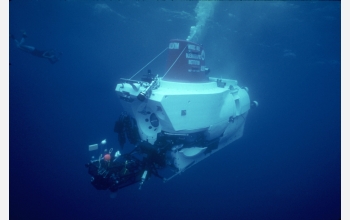Multimedia Gallery
Exploring Earth's subterranean biosphere in Alvin
Using the submersible Alvin, scientists are exploring indications of the Earth's subterranean biosphere. Submersibles like Alvin, which belongs to the Woods Hole Oceanographic Institution, enable scientists to study subterranean worlds that exist at the bottom of the oceans.
More about this image
Vaporous hot pools far beneath the Earth's surface support microbes that live in extreme temperatures and pressure. These microbes, some of which are bacteria, are called extremophiles, and their potentially far-reaching domain is called the subsurface biosphere.
National Science Foundation (NSF)-supported researcher John Parkes of the United Kingdom's University of Bristol discovered bacteria in a marine sediment core that substantiated the idea of superthermophilic organisms. While working with NSF's Ocean Drilling Program, Parkes found the bacteria living at a temperature of 169 Centigrade.
NSF-supported researcher John Baross and his colleague Jody Deming of the University of Washington offered new geochemical information collected from the Endeavour Segment of the Juan de Fuca Ridge in the deep Pacific Ocean off the U.S. West Coast. This exploration was also conducted in Alvin and indicated that organic materials--the building blocks of life--exist below the surface of hydrothermal vents along the Endeavour Segment.
NSF continues to support research on these subterranean worlds at the bottom of the sea and beyond.
Credit: Courtesy Woods Hole Oceanographic Institution
Images and other media in the National Science Foundation Multimedia Gallery are available for use in print and electronic material by NSF employees, members of the media, university staff, teachers and the general public. All media in the gallery are intended for personal, educational and nonprofit/non-commercial use only.
Images credited to the National Science Foundation, a federal agency, are in the public domain. The images were created by employees of the United States Government as part of their official duties or prepared by contractors as "works for hire" for NSF. You may freely use NSF-credited images and, at your discretion, credit NSF with a "Courtesy: National Science Foundation" notation.
Additional information about general usage can be found in Conditions.
Also Available:
Download the high-resolution JPG version of the image. (499.7 KB)
Use your mouse to right-click (Mac users may need to Ctrl-click) the link above and choose the option that will save the file or target to your computer.

